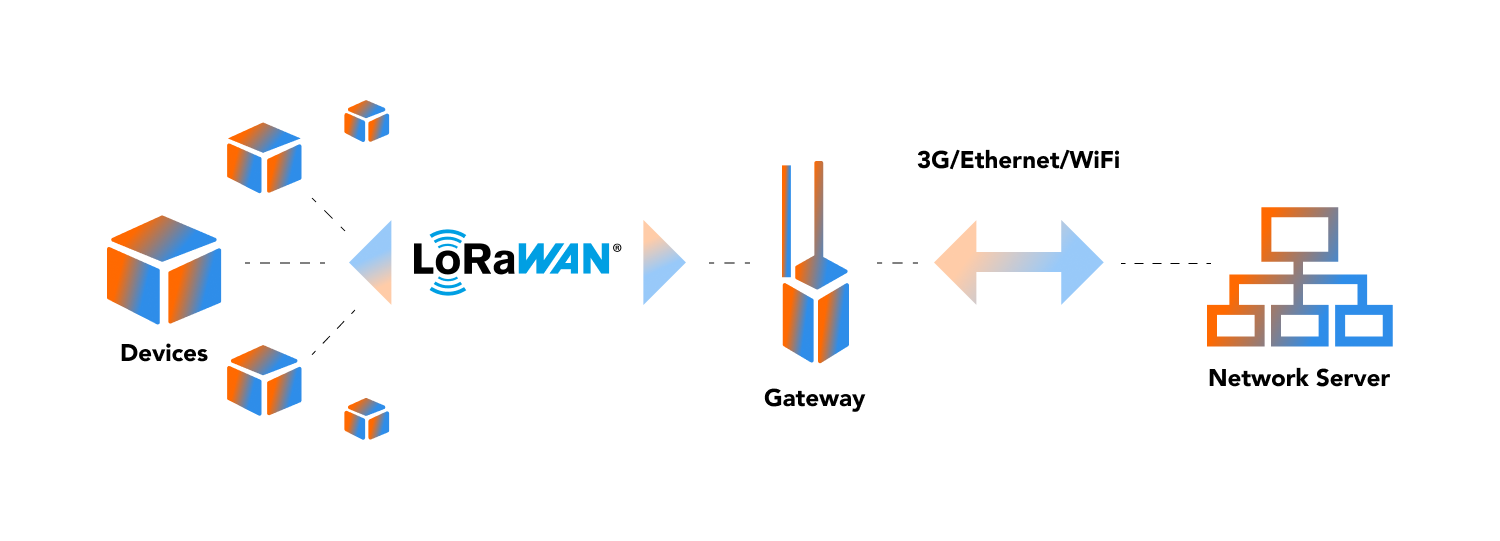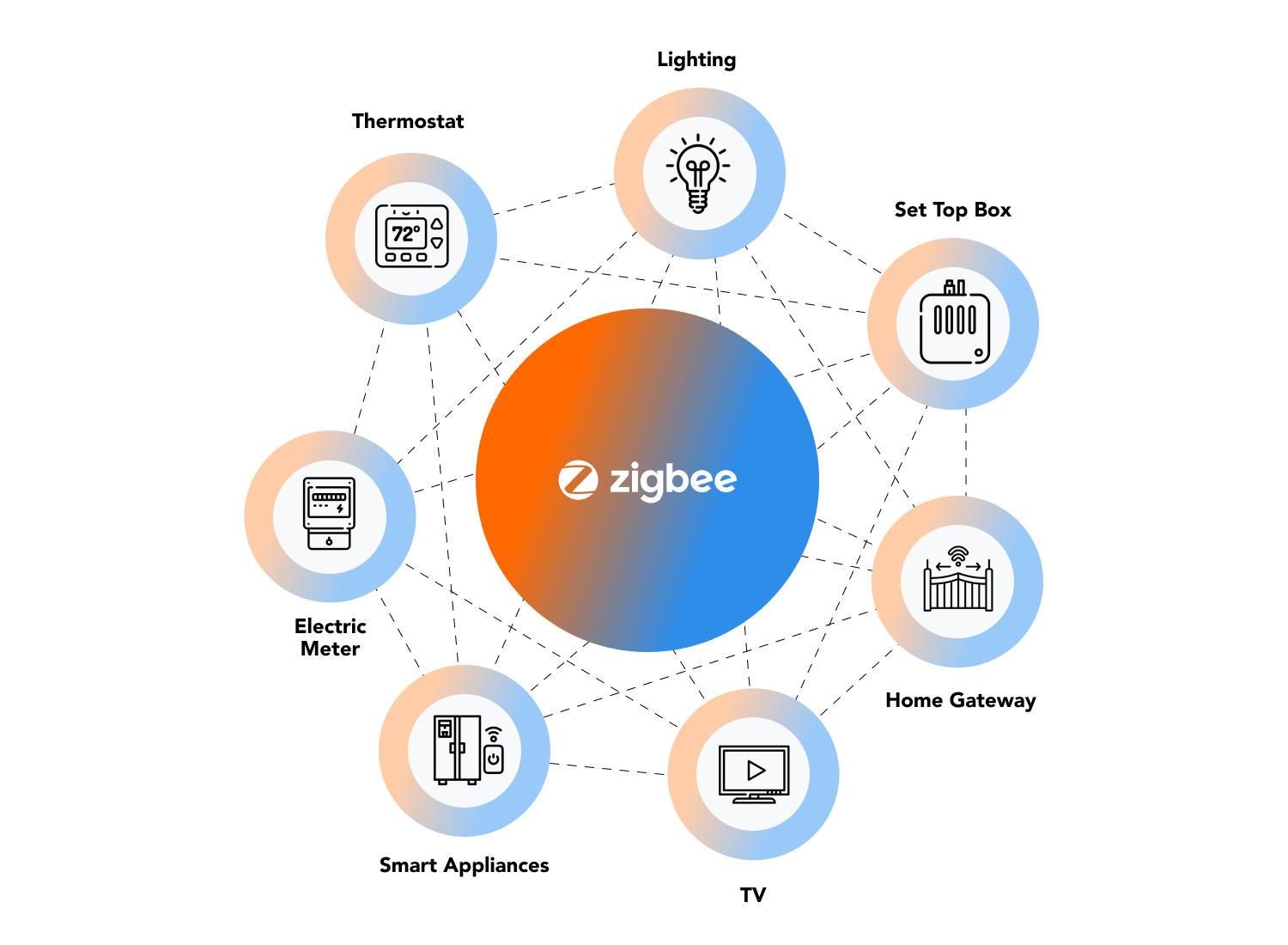In the fast-changing world of the Internet of Things (IoT), reliable wireless communication is crucial. Two options gaining significant traction are LoRaWAN and Zigbee. These technologies allow long-range communication between devices and are well-suited for a number of IoT applications.
Keep reading and we'll go through the features and potential applications of LoRaWAN and Zigbee as well as their strengths and weaknesses.
What is LoRaWAN?
LoRaWAN stands for Long Range Wide Area Network. It's a wireless protocol for long-range, low-power IoT applications. Using a LoRa modulation, it allows devices to communicate over long distances with low power consumption.
LoRaWan operates in various frequency bands, depending on the region. In Europe, it usually operates at 868 MHz, while in the United States, it operates at 915 MHz. Other regions might have their own designated frequency bands. This technology is commonly used for applications needing extended coverage, like smart agriculture, asset tracking, environmental monitoring, and smart cities.
How Does LoRaWAN Work?
A LoRaWan network consists of three primary elements: end devices, gateways, and a central network server.
End devices, also referred to as sensors or nodes, are low-power, battery-operated devices. They're responsible for gathering data from their environment and sending it to the gateways.
Gateways serve as mediators connecting the end devices and the central network server. They receive signals from the sensors and transmit them to the server using IP-based communication (like Ethernet or cellular networks). Gateways have the ability to cover extensive areas and support simultaneous connectivity with multiple end devices.
The central network server is vital for managing the LoRaWAN network. It receives data from gateways, processes it, and makes it available to application servers or cloud platforms. The server handles security, data routing, and network management to ensure reliable and secure communication between devices and applications.

Advantages for IoT applications:
- Long-range communication: LoRaWAN has exceptional coverage, allowing devices to communicate over several kilometers in open areas.
- Low power consumption: Similar to Zigbee, LoRaWAN devices operate with low power requirements, enabling long battery life. This makes them ideal for remote and battery-powered applications.
- Scalability: LoRaWAN networks can accommodate a large number of devices, making them suitable for extensive IoT deployments.
- Open-source gateways: There are open-source LoRa gateways available, allowing for customization and cost-effective solutions.
- Versatility: LoRaWAN supports a wide range of IoT applications, including environmental monitoring, smart agriculture, asset tracking, and more.
Setting up a LoRaWAN network usually requires LoRaWAN-compatible devices (sensors or nodes), gateways, and a central network server. Various companies offer LoRaWAN solutions and platforms that simplify the deployment and management of the network.
Weaknesses of LoRaWAN:
While LoRaWAN brings a number of advantages, it also has a few limitations:
- It has a lower data rate than other wireless communication technologies, which makes it unsuitable for high-speed data transfer applications.
- Its low-power and long-range characteristics can cause higher latency, affecting real-time applications that need immediate responses.
- LoRaWAN networks have limited capacity to support a high number of devices in densely populated areas. This impacts network performance in urban environments.
- Despite using dedicated frequency bands, LoRaWAN can experience interference from other devices or networks sharing the same spectrum. This impacts communication reliability and range.
- While LoRaWAN has basic security mechanisms, it may not offer the same level of security features as other communication protocols, resulting in limited security options. Additional security measures may be necessary for sensitive applications.
- Setting up a LoRaWAN network is a complex process that involves careful planning, including the strategic placement of gateways for the best coverage and connectivity. Deploying and configuring gateways and the network server may require technical expertise.
Despite its limitations, LoRaWAN is still a valuable technology for numerous IoT applications. Especially those that need long-range coverage, low power consumption, and cost-effectiveness.
What is Zigbee Technology?
Zigbee is another wireless communication technology, but it's specifically designed for low-power, short-range IoT applications. It can be used to establish mesh networks that connect various devices, enabling seamless communication between them.
Zigbee uses different frequency bands depending on the region. In most regions like North America and Europe, it operates on channels 11-26 within the 2.4 GHz band. In other parts of America, it uses the 915 MHz band. These frequency bands enable reliable short-range wireless communication in its networks.
Zigbee employs low data rates and uses minimal power, making it ideal for battery-powered devices. Its applications span home automation, smart lighting, security systems, and other IoT use cases that prioritize efficient and dependable wireless connectivity. Zigbee devices can actually create a network where they communicate with each other through a coordinator or gateway.
How Does Zigbee Work?
Zigbee works by forming a network of devices that communicate through a mesh network topology. The network is managed by a coordinator device, and other devices can join as routers or end devices.
It operates on the IEEE 802.15.4 standard, using a low-power, low-data rate wireless communication protocol.
Zigbee devices implement a software stack with multiple layers for communication. The coordinator manages the network and controls parameters while devices can function as end devices or routers to extend the network range. Devices using this technology from different manufacturers work together, ensuring compatibility.

Zigbee brings numerous benefits to IoT applications:
- Energy Efficiency: Zigbee is optimized for low-power operations, enabling devices to function on battery power for extended periods--making it ideal for energy-efficient IoT devices and applications.
- Mesh Networking: It employs a mesh network topology, allowing devices to communicate directly or through intermediate routers. This enhances coverage and range by relaying messages within the network.
- Interoperability: Zigbee devices from different manufacturers can seamlessly work together, ensuring compatibility and flexibility when building IoT systems. This allows users to select devices from various vendors without compatibility concerns.
- Reliable Communication: It utilizes a reliable communication protocol with built-in error detection and correction mechanisms. Zigbee dynamically adjusts to network conditions, ensuring consistent and robust communication between devices.
- Scalability: These networks can accommodate a large number of devices, making them scalable for extensive IoT deployments. Devices can easily join or leave the network, facilitating diverse applications.
- Security: Zigbee incorporates built-in security mechanisms to safeguard data and enable secure communication. It includes encryption, authentication, and access control features, bolstering the protection of IoT devices and networks.
- Cost-Effectiveness: It's a cost-effective solution for IoT applications. The technology is relatively affordable, and the interoperability of devices from different vendors allows for flexible and cost-efficient system configurations.
Zigbee also has some limitations to consider:
- It operates at comparatively lower data rates compared to some other wireless communication technologies, which can be a limitation for applications requiring high-speed data transfer.
- While Zigbee offers decent coverage within typical IoT ranges, it's not suitable for long-range communication. In scenarios with extensive distances or obstacles, additional routers or signal boosters may be necessary.
- Zigbee operates in the crowded 2.4 GHz frequency band. This makes it susceptible to interference from Wi-Fi networks, Bluetooth devices, and microwaves. This interference can impact the reliability of communication.
- Configuring and setting up a Zigbee network may require technical expertise. Precise planning, including router placement and network configuration, is essential to ensure optimal coverage and performance.
- Zigbee employs narrow bandwidth channels, restricting the amount of data that can be transmitted simultaneously. This can affect applications that necessitate high data throughput or real-time streaming.
- While Zigbee is recognized for its low power consumption, battery-powered devices may have limited range due to power constraints. This can impact the coverage and connectivity of devices in larger deployments.
Despite these weaknesses, Zigbee remains a popular choice for numerous IoT applications due to its energy efficiency, mesh networking capability, interoperability, and other advantages.
Choosing the Right Technology
LoRaWAN and Zigbee are two prominent wireless communication technologies that cater to different IoT application needs. Zigbee offers low-power, short-range communication for applications in proximity. LoRaWAN enables long-range, low-power communication across extensive coverage areas. Understanding their features, strengths, and weaknesses is crucial for selecting the most suitable technology to realize the full potential of your IoT deployment.
.png?width=1600&height=800&name=LoRaWAN%20vs%20Zigbee%20(1).png)

